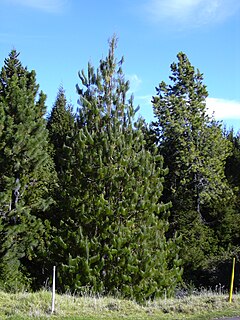Related Research Articles

The Pinophyta, also known as Coniferophyta or Coniferae, or commonly as conifers, are a division of vascular land plants containing a single extant class, Pinopsida. They are cone-bearing seed plants, a subset of gymnosperms. All extant conifers are perennial woody plants with secondary growth. The great majority are trees, though a few are shrubs. Examples include cedars, Douglas firs, cypresses, firs, junipers, kauri, larches, pines, hemlocks, redwoods, spruces, and yews. As of 1998, the division Pinophyta was estimated to contain eight families, 68 genera, and 629 living species.

The gymnosperms, also known as Acrogymnospermae, are a group of seed-producing plants that includes conifers, cycads, Ginkgo, and gnetophytes. The term "gymnosperm" comes from the composite word in Greek: γυμνόσπερμος, literally meaning "naked seeds". The name is based on the unenclosed condition of their seeds. The non-encased condition of their seeds contrasts with the seeds and ovules of flowering plants (angiosperms), which are enclosed within an ovary. Gymnosperm seeds develop either on the surface of scales or leaves, which are often modified to form cones, or solitary as in yew, Torreya, Ginkgo.

Peavy Arboretum is an arboretum operated by Oregon State University and located on Arboretum Road, Corvallis, Oregon. It is open to the public daily without charge.

Pinus patula, commonly known as patula pine, spreading-leaved pine, or Mexican weeping pine, and in Spanish as pino patula or pino llorón, is a tree native to the highlands of Mexico. It grows from 24° to 18° North latitude and 1,800–2,700 m (5,900–8,900 ft) above sea level. The tree grows up to 30 m (98 ft) tall. It cannot withstand long periods of temperatures as low as −10 °C (14 °F), but resists occasional brief dips below 0 °C (32 °F). It is moderately drought-tolerant, and in this respect is superior to Pinus taeda. The average annual rainfall in its native habitat is from 750 to 2000 mm. This happens mostly in summer, but in a little area of the State of Veracruz on the Sierra Madre Oriental its habitat is rainy the year round.
Mexican conifers extend mainly across the main mountain ranges Sierra Madre Oriental, Sierra Madre Occidental and the Trans-Mexican Volcanic Belt. Enclosed between these mountains there are dispersed groups of conifers in mid and high elevations valleys when rainfall conditions allow their growth. Mexican conifers grow in some places often associated with oaks.
This is an alphabetical list of useful timber trees, indigenous and exotic, growing in the Gauteng area of South Africa. These trees range in size up to some 1.5m DBH, such as Cedrus deodara, the Himalayan Cedar. Hobbyists will seek out even small pieces of highly valued timber, such as Buxus macowanii, the South African counterpart of Buxus sempervirens, for turnery or the making of boxes and small items. Despite the wealth of useful woods available in Gauteng, most of the trees, felled or fallen, are dumped or cut into short lengths for fuel. Trees grown in urban or suburban environments are rarely pruned and are consequently often knotty. Timber frequently holds nails, wire and spikes, attesting to a variety of abuse during the lifetime of a tree, and requiring the use of a metal detector by the sawmiller. Garden cuttings and dead leaves are occasionally piled next to trees and burnt, leaving charred scars and inclusions.
The anthophytes are a grouping of plant taxa bearing flower-like reproductive structures. They were formerly thought to be a clade comprising plants bearing flower-like structures. The group contained the angiosperms - the extant flowering plants, such as roses and grasses - as well as the Gnetales and the extinct Bennettitales.
References
- 1 2 Campbell, Reece (2005). Phylum Coniferophyta (7th ed.). p. 595.
- ↑ Lott, John N. A; Liu, Jessica C; Pennell, Kelly A; Lesage, Aude; West, M Marcia (2002). "Iron-rich particles and globoids in embryos of seeds from phyla Coniferophyta, Cycadophyta, Gnetophyta, and Ginkgophyta: characteristics of early seed plants". Canadian Journal of Botany. 80 (9): 954–961. doi:10.1139/b02-083.
- ↑ Butler, Rhett A. (1 July 2019). "Total number of plant species by country". Mongabay. Retrieved 21 July 2019.
- ↑ "Vegetation of South Africa". PlantZAfrica.com. SA National Biodiversity Institute. Retrieved 24 July 2019.
- 1 2 3 4 5 6 7 8 9 10 11 12 13 14 15 16 17 18 19 20 21 22 23 24 25 26 27 28 29 30 31 32 33 "species_checklist_20180710.csv". South African National Biodiversity Institute. Retrieved 27 September 2020.